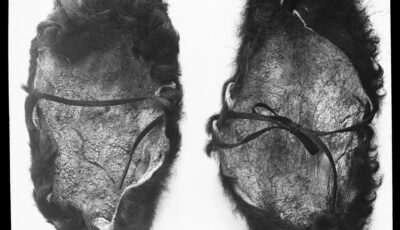Everyone knows the Irish sweater, the famous sweater from the Aran Islands, made from virgin sheep’s wool. A garment renowned for its strength and warmth, perfect for fishermen who wanted to take to the sea while protecting themselves from the cold and damp!
But did you know that the Irish archipelago didn’t just create this iconic garment? The Aran Islands are also known as the birthplace of pampooties: handcrafted leather shoes in the pure Gaelic tradition!

Pampoogies made on the Aran Islands –
daves_archive1 – cc
Whether on the island of Inishmore, Inisheer or Inishmaan, families living on the Aran Islands have never been short of ideas for warm clothing and footwear.
The harshness of local life called for effective solutions, and the local population has always been inventive in coping with the precariousness of nature.
Pampoos are further proof. These shoes are the fruit of the labor of local fishing families. Excellent craftsmen, they created the perfect shoe to cope with the conditions of their island life.
Pampooties are a handcrafted shoe steeped in history, made from a single piece of raw, untanned leather (with exposed bristles for added protection). This piece was then rolled and folded around the foot, then sewn to the wearer, using string or leather thongs.
The Irish wore them with a thick pair of woollen socks for added comfort. A perfect system for keeping warm while progressing on land or sea in hostile conditions (slippery, wet, steep, stony, etc.). Flexible, they made it easy to make headway on the ground, while gripping the soil effectively, without the risk of slipping.
Pointed at the tips of the toes, these makeshift shoes also effectively protected the toes from impact: a considerable asset for workers of the time!
Above all, they kept feet warm, while allowing the skin to breathe.
Inexpensive to manufacture, they provided effective protection (a bit like our modern safety shoes), while keeping your feet light. These were real assets, helping to reduce fatigue, especially when carrying heavy loads.
But beware: pampoos also had major drawbacks. Starting with their useful life. These makeshift shoes only lasted a few weeks, and had to be discarded after a few days.
Indeed, Ireland is known as a hostile land, with its regular downpours, soggy ground and proximity to the ocean. In fact, the pampoos systematically ended up soaking up water: the water seeped into the leather, leading to rapid rotting of the shoe.
The only solution was to get rid of them, and find another piece of leather to make a new pair of shoes.
In the Aran Islands, fishermen and peat harvesters were the main users of this type of shoe. They enabled workers to move around flexibly (far from the solidity of clogs), while staying warm.
They were a major asset when it came to getting around a fishing boat without slipping too much… or getting around a peat bog without losing your shoe!
In fact, pampoties were so popular that they also spread to mainland Ireland, especially in County Galway.
However, it was common knowledge that the best were essentially made on the Aran Islands and not elsewhere.
So, of course, pampoties are now historic handmade shoes, and you’ll be hard pressed to find them in the shops, even on the Aran Islands. Nowadays, they are regarded as genuine historical pieces, and can be found more easily in national museums than in shops!
It has to be said that these shoes were mainly worn in the 1800-1900s, and eventually became obsolete with the progress of the textile industry and technical footwear.
Nevertheless, the Irish Gaeltacht are still strongly attached to these handcrafted shoes, and you’ll still find stores or historical websites offering patterns, leather parts and manuals to explain how to create them yourself.
Typically, these manuals come with examples, photos and a preview of the final rendering. Perfect for trying your hand at making your own shoes!
Although pampoos are no longer a common sight on the streets, they have been replaced by ghillies, the traditional shoes worn by Irish dancers. Although they bear little resemblance to their ancestors, specialists believe they are their worthy successors.
It features many of the same characteristics, including the use of leather (this time tanned), ankle-high straps, and a pointed toe shape that follows the shape of the foot.
Very common, ghillies can be found all over the country, mainly in specialist stores. Expect to pay at least €50 for a pair, but prices can go up depending on brand and quality.